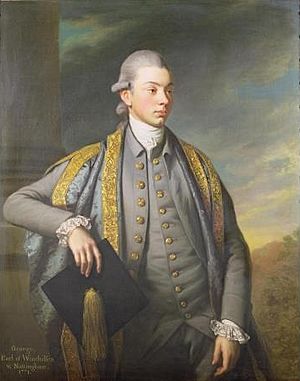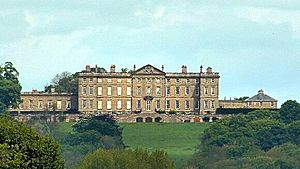George Finch, 9th Earl of Winchilsea facts for kids
Quick facts for kids
The Earl of Winchilsea
|
|
|---|---|
 |
|
| Lord Lieutenant of Rutland | |
| In office 12 April 1779 – 2 August 1826 |
|
| Preceded by | The Earl of Exeter |
| Succeeded by | The Marquess of Exeter |
| Personal details | |
| Born |
George Finch
4 November 1752 |
| Died | 2 August 1826 (aged 73) |
| Children | George Finch (Born outside marriage) |
| Parents | |
George Finch, 9th Earl of Winchilsea (born November 4, 1752 – died August 2, 1826) was an important person in English history. He was a nobleman, an army officer, and a passionate cricketer. He helped shape the game of cricket, not just by playing, but also by supporting it and helping to organize it.
George Finch served in the army during the American Revolutionary War from 1779 to 1783. He held temporary ranks like major and lieutenant-colonel. He was also the first president of the Royal Institution, a famous science organization. He even helped it get support from King George III.
Contents
Early Life and Family
George Finch was the son of William Finch and Charlotte Fermor. His grandfather was Daniel Finch, 2nd Earl of Nottingham. George had a sister named Sophia.
When his father passed away in 1766, George inherited the title of Earl of Winchilsea in 1769. He received it from his uncle, Daniel Finch, 8th Earl of Winchilsea and 3rd Earl of Nottingham, who had no children. Along with the title, George also gained his uncle's large estate at Burley-on-the-Hill in Rutland.
In the 1770s, George Finch visited Florence, Italy. He can be seen in a famous painting by Johann Zoffany called the Tribuna of the Uffizi.
Contributions to Cricket
A. A. Thomson once wrote that George Finch "would go anywhere for a game of cricket." He played a lot and is one of the most recorded players from the 1700s. Even though he was 33 when he first played in a major match, he played in at least 128 top-level games between 1786 and 1804. Many other games he played in might not have records anymore.
George Finch was an amateur player, meaning he played for fun, not for money. He was very active in the sport, but he wasn't always the best player. His batting scores were often quite low.
Founding the White Conduit Club
Around 1784, George Finch was one of the main people who started the White Conduit Club (WCC). This club was called "White Conduit" because they played on White Conduit Fields. It was meant to be a special club where "only gentlemen" could play. However, the club also hired professional players, like the bowler Thomas Lord. Thomas Lord was known for his business skills as well as his bowling.
The White Conduit Club played its first major match in 1785. The White Conduit Fields were open to the public, which meant people could watch the games. Sometimes, the crowd would get noisy and share their opinions loudly. The gentlemen of the club didn't like these interruptions. So, they decided to find a more private place to play.
Creating Lord's Cricket Ground
George Finch and Colonel Charles Lennox asked Thomas Lord to find a new cricket ground. They promised to help him if he lost any money on the idea. Thomas Lord rented some land in Marylebone, where Dorset Square is today. This land was prepared and opened in 1787.
The first known match at this new ground was on May 21, 1787. It was played between the White Conduit Club and Middlesex. This new place became Lord's first ground. Since it was in Marylebone, the White Conduit Club changed its name to the Marylebone Cricket Club (MCC) when they moved there. George Finch was one of the most important leaders of the MCC in its early days.
Personal Life
Lord Winchilsea never got married. He passed away in 1826. His titles were then passed on to his cousin's son, George William Finch-Hatton. George Finch had a son named George Finch, who later became a politician. His father left him Burley House.
| Honorary titles
|
||
|---|---|---|
| Preceded by The Earl of Exeter |
Lord Lieutenant of Rutland 1779–1826 |
Succeeded by The Marquess of Exeter |
| Peerage of England | ||
| Preceded by Daniel Finch |
Earl of Winchilsea 1769–1826 |
Succeeded by George Finch-Hatton |
| Earl of Nottingham 7th creation 1769–1826 |
||


